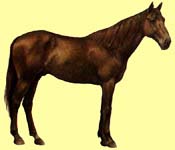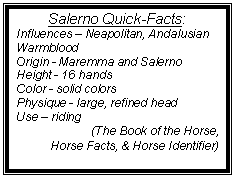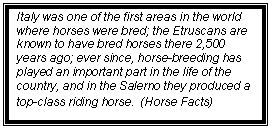|
|
SalernoPersano, Salernitano |
|
|
SalernoPersano, Salernitano |
 This meso-dolichomorphic breed originates from the Italian province of Campania, and adjoining Puglia, and it is of national significance. This Mediterranean warmblood dates to the 18th century, where it was bred for use under saddle in royal stables. It is the most attractive of the Italian warmbloods, with famous jumpers heralding from its Morese Stud. Merano and Posillipo, both ridden by Italian Raimondo d'Inzeo, are two of the greatest Italian show jumpers.
This meso-dolichomorphic breed originates from the Italian province of Campania, and adjoining Puglia, and it is of national significance. This Mediterranean warmblood dates to the 18th century, where it was bred for use under saddle in royal stables. It is the most attractive of the Italian warmbloods, with famous jumpers heralding from its Morese Stud. Merano and Posillipo, both ridden by Italian Raimondo d'Inzeo, are two of the greatest Italian show jumpers.
Descending from the Neapolitan, popular during the Middle Ages, the Salerno has experienced important infusions of Spanish (Andalusian) and Oriental blood. The Morese Stude is located in close proximity to where the stud of the Persano horse, founded by the Bourbon Charles III in the early 16th century, once stood. King Charles III of Naples, then also of Spain, promoted this horse during the Bourbon period, from 1783 onward. The Neapolitan horses were bred near Sorrento and Naples Italy, near the Persano stud. This region later became the Salerno Province in the Italian Republic. These horses from Persano were based on the Neapolitan horses, which had infusion of Spanish and Barb blood. Then called Persano for the area where they were bred, these horses became regarded as the finest school horses of their day. They were greatly admired for high, fiery action and their exceptional leg strength. Local horses from Salerno and Ofanto valleys were introduced to the breeding program, as well as Arabian and Spanish imports. A distinctive, quality riding horse resulted from these crosses. The Spanish horse improved the Persano's conformation and gave it strength, agility and spirit.
 When Italy was unified, becaming known as the Italian Republic, the breeding program for the Persano suffered greatly and in 1874 it was suppressed. Breeding of the Persano was revived in 1900, but the breed became increasing referred to as Salerno for one of the valleys in the region. At the beginning of the twentieth century, however, the Salerno began to be slowly and carefully restored by local breeders. It was first used as a carriage horse, later becoming a superb riding horse. The systematic use of English Thoroughbred stallions in the breeding program improved the riding qualities. Rather than using Arabs, as was done in the past, the Thoroughbred blood was used to place particular emphasis on good staying power. Thoroughbreds were used to add size, quality, courage, and a greater freedom of action to the breed. This resulted in an increase in the size of the Salerno and the once common grey coat has almost totally disappeared.
When Italy was unified, becaming known as the Italian Republic, the breeding program for the Persano suffered greatly and in 1874 it was suppressed. Breeding of the Persano was revived in 1900, but the breed became increasing referred to as Salerno for one of the valleys in the region. At the beginning of the twentieth century, however, the Salerno began to be slowly and carefully restored by local breeders. It was first used as a carriage horse, later becoming a superb riding horse. The systematic use of English Thoroughbred stallions in the breeding program improved the riding qualities. Rather than using Arabs, as was done in the past, the Thoroughbred blood was used to place particular emphasis on good staying power. Thoroughbreds were used to add size, quality, courage, and a greater freedom of action to the breed. This resulted in an increase in the size of the Salerno and the once common grey coat has almost totally disappeared.
It stands between 16.1 and 17 hands high and may be bay, chestnut, black or grey (all solid). It has a light head that is well set-on, with a straight profile and wide, square forehead. It has a bold intelligent expressin in the face; and the head reflects its Thoroughbred influence. The eyes are lively and the nostrils are flared. It has a long, well set-on neck and the withers are quite pronounced and muscular. The long shoulder is nicely sloping, excellent for riding, and complemented by its strong quarters. It has a proportional conformation with a high standard from the Thoroughbred influence. It has good depth in the girth; its back is well-proportioned; its loins are short; and its muscular croup is rounded. Its legs have adequate bone; its slender cannons are strong; the well-defined tendons are clean; and the uniformly good hooves are of strong horn.
 With a quiet, balanced and energetic temperament, the Salerno makes a good jumper and riding horse. Once popular for cavalry mounts, the Salerno is used more for recreation and competition riding today. Combined with the Maremannos from central and western regions near Tuscany, Italy, the Salerno has been used extensively in the development of Italy’s new saddle breed. The once tough, fast and frugal Maremmano was improved with infusions of British Thoroughbred blood to increase its quality prior to merging into the Italian Saddle Horse amalgam.
With a quiet, balanced and energetic temperament, the Salerno makes a good jumper and riding horse. Once popular for cavalry mounts, the Salerno is used more for recreation and competition riding today. Combined with the Maremannos from central and western regions near Tuscany, Italy, the Salerno has been used extensively in the development of Italy’s new saddle breed. The once tough, fast and frugal Maremmano was improved with infusions of British Thoroughbred blood to increase its quality prior to merging into the Italian Saddle Horse amalgam.
For more information visit:

|
© 1997-2007
NW Breyer Horse Club & Refiner of Gold Creations Equinealities in place since 1997, Section in place 2001, Updated 3/13/2007 |



|
| ||

|
|||||